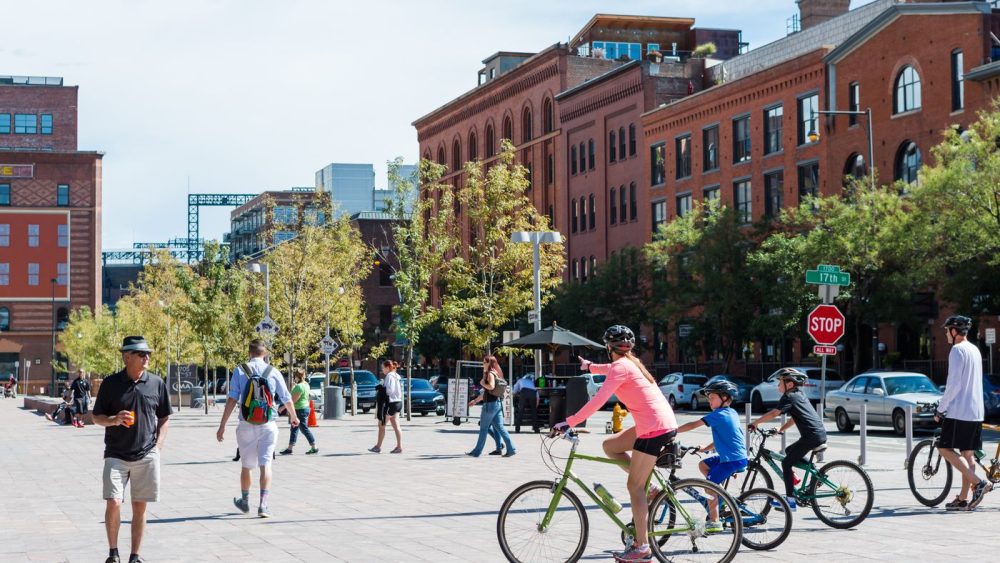City planners say we have to rethink the way we build urban areas to make them more sustainable, healthy and just. The so-called 15-minute city is one idea. But are they viable?
As recently as a two decades ago, more people lived in the countryside than in urban areas. But that has since changed. Around 56% of the global population are now at home in cities, and the trend continues to rise. According to the United Nations, two thirds of the roughly 10 billion people that will inhabit planet earth by the year 2050 will live in built-up areas.
This consistant city spread has revealed serious cracks in their planning, shedding light on issues such as social injustice and exclusion, inadequate public transportation networks and smog-related health issues. One idea that has been gaining traction recently as a way towards more sustainable, livable and healthy futures are 15 minutes cities.
The idea behind the concept is to build cities in such a way that most daily necessities and services are located within a 15-minute walk or bike ride. Carlo Moreno, urbanist and professor at the Sorbonne University in Paris first came up with the idea in 2016. He wanted everyone to have easy access to shops, schools, doctors, the gym, parks, restaurants and cultural institutions.
Many people who live in cities today can only dream of that, and instead have to deal with traffic jams or poor public transportation to get where they want to go.
Human-centered design
Benjamin Büttner, mobility expert at the Technical University Munich says that in order to create more sustainable cities, things like green spaces, places to do sport, cinemas and shops need to be moved to where people live, not vice versa.
And that doesn’t mean they have to be demolished and rebuilt, but that already existing public space needs to be rearranged.
The 15-minute city also offers a mobility concept: fewer cars and more space for cyclists and pedestrians, safe paths for children, people with disabilities or the elderly and places for social interaction.
“Cars are a problem, at least in urban centers. They take up too much space and they can hamper active mobility,” Büttner said.
From Paris to Shanghai: more and more cities are reconstructing
There are already 16 cities worldwide that have implemented the 15-minute city concept or similar ideas, or are working on doing so. The approaches vary, with some cities looking to implement 20-minute concepts, others 10-minute ones, and yet others focused on either individual urban districts or set on recreating the entire city.
Among the pioneers is the French capital. After Carlos Moreno introduced his concept in 2016, the mayor of Paris, Anne Hidalgo, presented it in her re-election campaign and began implementing it during the pandemic.
The core of the Paris concept sees schools as “capitals”, making them the center of each neighborhood. Schoolyards are being refurbished into parks to make them accessible for other activities after classes and at the weekend.
Paris also wants to repurpose half of its 140,000 car parking spaces, turning them into green areas, playgrounds, neighborhood meetups or bike parking spots. Streets right across Paris are due to be bike-friendly by 2026.
In 2016, Shanghai announced plans to introduce what it calls “15-minute community life circles,” a plan that would ensure all day-to-day activities are within 15-minutes walking distance. Another 50 Chinese cities are looking to implement the concept.
An initiative in Great Britain is also aimed at achieving a better quality of life for city dwellers. As part of its countrywide re-naturalization program, the British government announced plans to make it possible for everyone to reach green areas or open water within a 15-minute walk from their home.
The “Superilles” or super districts of Barcelona
The Spanish city of Barcelona has been experimenting with so-called “Superilles” or super districts. The concept takes several housing blocks and puts them into a superblock. Only residents or delivery services have access to cars and the maximum speed limit is 10 kilometers (6 miles) an hour.
Many streets are blocked by cars and are instead being used in different ways. Former parking lots have been given over to trees, vegetables, and flowers, and are now places where children can play and people can while away their time on benches in the shade.
“Tactical urbanism” is what Büttner calls this approach. The concept is being tested for two to six months “in order to see whether the situation has gotten better or worse,” he says. “In that case, you can still say ‘let’s go back to the way things were before.’ But if it’s got better then you can make it a lasting measure.”
Currently, 60% of public space in Barcelona and 85% of streets are used for traffic. More than half the city’s residents are faced with noise and dangerous air pollution, which is considerably higher than World Health Organization limits. The new districts should reduce motorized traffic by 21%.
Will less traffic harm businesses?
Studies show that more bike and pedestrian traffic in cities save money, as less is spent on road maintenance and health sectors.
The positive effects of cycling are being estimated at more than €90 billion ($96 billion) in the EU alone. By comparison, mobilized traffic causes more than €800 billion in costs for health, environment, and infrastructure every year.
Many shop owners are concerned that the 15-minute city idea will cause a collapse in sales since customers can no longer reach them by car. But in the western US city of Portland, the 20% drop in car traffic following the introduction of a 20-minute city concept, also led to an additional $1.2 billion staying in the local economy.
15-mins city concept different for every place
In order for as many people as possible to benefit from changing cities, and to avoid any new imbalance and gentrification, experts highlight the need to roll out the concept across different districts and ensure those taking part have a good social mix. That also requires rethinking regulations and traditional planning categories, such as city centers, housing districts, suburbs, and commercial areas which have led to inequality and exclusion in cities worldwide.
According to Büttner, the political will and courage of politicians and administrations are vital, as well as the dialogue with citizens and all parties involved. Because there isn’t a set solution for all cities.
Every place and every social, economic, and ecological structure of a city is different, Büttner says. So deciding which measures are best, depends on the context.





















